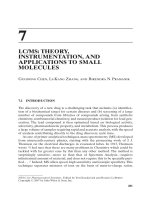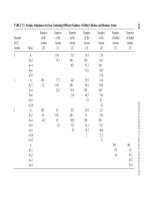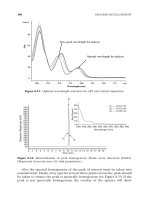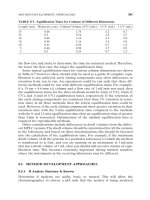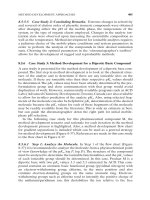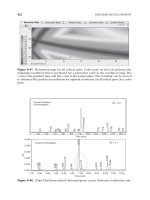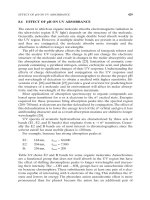Tài liệu Draining for Profit, and Draining for Health by George E. Waring docx
Bạn đang xem bản rút gọn của tài liệu. Xem và tải ngay bản đầy đủ của tài liệu tại đây (6.94 MB, 298 trang )
The Project Gutenberg EBook of Draining for Profit, and Drain-
ing for Health by George E. Waring
This eBook is for the use of anyone anywhere at no cost and
with almost no restrictions whatsoever. You may copy it, give
it away or re-use it under the terms of the Project Gutenberg
License included with this eBook or online at en-
berg.org/license
Title: Draining for Profit, and Draining for Health
Author: George E. Waring
Release Date: October 4, 2006 [Ebook 19465]
Language: English
***START OF THE PROJECT GUTENBERG EBOOK
DRAINING FOR PROFIT, AND DRAINING FOR
HEALTH***
Draining for Profit, and Draining for
Health
by George E. Waring
Edition 1, (October 4, 2006)
New York
Orange Judd & Company,
245 Broadway.
Entered according to Act of Congress, in the year 1867, by
ORANGE JUDD & CO.
At the Clerk's Office of the District Court of the United States
for this Southern District of New-York.
Lovejoy & Son,
Electrotypers and Stereotypers.
15 Vandewater street N.Y.
[003]
In presenting this book to the public the writer desires to say that,
having in view the great importance of thorough work in land
draining, and believing it advisable to avoid every thing which
might be construed into an approval of half-way measures, he
has purposely taken the most radical view of the whole subject,
and has endeavored to emphasize the necessity for the utmost
thoroughness in all draining operations, from the first staking of
the lines to the final filling-in of the ditches.
That it is sometimes necessary, because of limited means,
or limited time, or for other good reasons, to drain partially or
imperfectly, or with a view only to temporary results, is freely
acknowledged. In these cases the occasion for less completeness
in the work must determine the extent to which the directions
herein laid down are to be disregarded; but it is believed that,
even in such cases, the principles on which those directions are
founded should be always borne in mind.
NEWPORT, R.I., 1867.
Illustrations
Fig. 1 - A DRY SOIL. . . . . . . . . . . . . . . . . . . . . 6
Fig. 2 - A WET SOIL. . . . . . . . . . . . . . . . . . . . 7
Fig. 3 - A DRAINED SOIL. . . . . . . . . . . . . . . . . 8
Fig. 4 - MAP OF LAND, WITH SWAMPS, ROCKS,
SPRINGS AND TREES. INTENDED TO REPRE-
SENT A FIELD OF TEN ACRES BEFORE DRAINING. 43
Fig. 5 - MAP WITH 50-FOOT SQUARES, AND CON-
TOUR LINES. . . . . . . . . . . . . . . . . . . . . . . 44
Fig. 6 - LEVELLING INSTRUMENT. . . . . . . . . . . . 45
Fig. 7 - LEVELLING ROD. . . . . . . . . . . . . . . . . 46
Fig. 8 - MAP WITH CONTOUR LINES. . . . . . . . . . 48
Fig. 9 - WELL'S CLINOMETER. . . . . . . . . . . . . . 49
Fig. 10 - STONE PIT TO CONNECT SPRING WITH
DRAIN. . . . . . . . . . . . . . . . . . . . . . . . . . 53
Fig. 11 - STONE AND TILE BASIN FOR SPRING
WITH DRAIN. . . . . . . . . . . . . . . . . . . . . . 54
Fig. 12 - LINE OF SATURATION BETWEEN DRAINS. 59
Fig. 13 - HORSE-SHOE TILE. . . . . . . . . . . . . . . . 72
Fig. 14 - SOLE TILE. . . . . . . . . . . . . . . . . . . . . 75
Fig. 15 - DOUBLE-SOLE TILE. . . . . . . . . . . . . . . 75
Fig. 16 - ROUND TILE AND COLLAR, AND THE
SAME AS LAID. . . . . . . . . . . . . . . . . . . . . 76
Fig. 19 - THREE PROFILES OF DRAINS, WITH DIF-
FERENT INCLINATIONS. . . . . . . . . . . . . . . . 91
Fig. 20 - MAP WITH DRAINS AND CONTOUR LINES. 97
Fig. 21 - PROFILE OF DRAIN C. . . . . . . . . . . . . . 105
Fig. 22 - SET OF TOOLS. . . . . . . . . . . . . . . . . . 116
Fig. 23 - OUTLET, SECURED WITH MASONRY AND
GRATING. . . . . . . . . . . . . . . . . . . . . . . . 120
x Draining for Profit, and Draining for Health
Fig. 24 - SILT-BASIN, BUILT TO THE SURFACE. . . . 123
Fig. 25 - FINISHING SPADE. . . . . . . . . . . . . . . . 125
Fig. 26 - FINISHING SCOOP. . . . . . . . . . . . . . . . 126
Fig. 27 - BRACING THE SIDES IN SOFT LAND. . . . . 127
Fig. 28 - MEASURING STAFF. . . . . . . . . . . . . . . 128
Fig. 29 - BONING ROD. . . . . . . . . . . . . . . . . . . 130
Fig. 30 - POSITION OF WORKMAN AND USE OF
FINISHING SCOOP. . . . . . . . . . . . . . . . . . . 131
Fig. 31 - SIGHTING BY THE BONING-RODS. . . . . . 131
Fig. 32 - PICK FOR DRESSING AND PREFORATING
TILE. . . . . . . . . . . . . . . . . . . . . . . . . . . 136
Fig. 33 - LATERAL DRAIN ENTERING AT TOP. . . . . 139
Fig. 34 - SECTIONAL VIEW OF JOINT. . . . . . . . . . 139
Fig. 35 - SQUARE BRICK SILT-BASIN. . . . . . . . . . 140
Fig. 36 - SILT-BASIN OF VITRIFIED PIPE. . . . . . . . 141
Fig. 37 - TILE SILT-BASIN. . . . . . . . . . . . . . . . . 142
Fig. 38 - MAUL FOR RAMMING. . . . . . . . . . . . . 144
Fig. 39 - BOARD SCRAPER FOR FILLING DITCHES. . 147
Fig. 40 -CROSS-SECTIONOFDITCH(FILLED),WITH
FURROW AT EACH SIDE. . . . . . . . . . . . . . . 148
Fig. 41 - FOOT PICK. . . . . . . . . . . . . . . . . . . . 163
Fig. 42 - PUG-MILL. . . . . . . . . . . . . . . . . . . . . 188
Fig. 43 - PLATE OF DIES. . . . . . . . . . . . . . . . . . 189
Fig. 44 - CHEAP WOODEN MACHINE. . . . . . . . . . 190
Fig. 45 - MANDRIL FOR CARRYING TILES FROM
MACHINE. . . . . . . . . . . . . . . . . . . . . . . . 191
Fig. 46 - CLAY-KILN. . . . . . . . . . . . . . . . . . . . 193
Fig. 47 - DYKE AND DITCH. . . . . . . . . . . . . . . . 205
Fig. 48 - OLD STYLE HOUSE DRAINAGE AND
SEWERAGE. . . . . . . . . . . . . . . . . . . . . . . 243
Fig. 49 - MODERN HOUSE DRAINAGE AND SEW-
ERAGE. . . . . . . . . . . . . . . . . . . . . . . . . . 243
Contents
CHAPTER I. - LAND TO BE DRAINED AND THE
REASONS WHY. . . . . . . . . . . . . . . . . . . . . 1
CHAPTER II. - HOW DRAINS ACT, AND HOW THEY
AFFECT THE SOIL . . . . . . . . . . . . . . . . . . 15
CHAPTER III. - HOW TO GO TO WORK TO LAY OUT
A SYSTEM OF DRAINS. . . . . . . . . . . . . . . . 39
CHAPTER IV. - HOW TO MAKE THE DRAINS. . . . . 115
CHAPTER V. - HOW TO TAKE CARE OF DRAINS
AND DRAINED LAND. . . . . . . . . . . . . . . . . 151
CHAPTER VI. - WHAT DRAINING COSTS. . . . . . . . 157
CHAPTER VII. - "WILL IT PAY?" . . . . . . . . . . . . 169
CHAPTER VIII. - HOW TO MAKE DRAINING TILES. . 183
CHAPTER IX. - THE RECLAIMING OF SALT
MARSHES. . . . . . . . . . . . . . . . . . . . . . . . 199
CHAPTER X. - MALARIAL DISEASES. . . . . . . . . . 215
CHAPTER XI. - HOUSE DRAINAGE AND TOWN
SEWERAGE IN THEIR RELATIONS TO THE PUB-
LIC HEALTH. . . . . . . . . . . . . . . . . . . . . . 229
INDEX . . . . . . . . . . . . . . . . . . . . . . . . . . . 247
[007]
CHAPTER I. - LAND TO BE
DRAINED AND THE REASONS
WHY.
Land which requires draining hangs out a sign of its condition,
more or less clear, according to its circumstances, but always
unmistakable to the practiced eye. Sometimes it is the broad
banner of standing water, or dark, wet streaks in plowed land,
when all should be dry and of even color; sometimes only a
fluttering rag of distress in curling corn, or wide-cracking clay,
or feeble, spindling, shivering grain, which has survived a pre-
carious winter, on the ice-stilts that have stretched its crown
above a wet soil; sometimes the quarantine flag of rank growth
and dank miasmatic fogs.
To recognize these indications is the first office of the drainer;
the second, to remove the causes from which they arise.
If a rule could be adopted which would cover the varied cir-
cumstances of different soils, it would be somewhat as follows:
All lands, of whatever texture or kind, in which the spaces
between the particles of soil are filled with water, (whether from
rain or from springs,) within less than four feet of the surface
of the ground, except during and immediately after heavy rains,
require draining.
Of course, the particles of the soil cannot be made dry, nor
should they be; but, although they should be moist themselves,
they should be surrounded with air, not with water. To illustrate
this: suppose that water be poured into a barrel filled with chips
2 Draining for Profit, and Draining for Health
of wood until it runs over at the top. The spaces between the
chips will be filled with water, and the chips themselves will[008]
absorb enough to become thoroughly wet;—this represents the
worst condition of a wet soil. If an opening be made at the
bottom of the barrel, the water which fills the spaces between the
chips will be drawn off, and its place will be taken by air, while
the chips themselves will remain wet from the water which they
hold by absorption. A drain at the bottom of a wet field draws
away the water from the free spaces between its particles, and its
place is taken by air, while the particles hold, by attraction, the
moisture necessary to a healthy condition of the soil.
There are vast areas of land in this country which do not
need draining. The whole range of sands, gravels, light loams
and moulds allow water to pass freely through them, and are
sufficiently drained by nature, provided, they are as open at the
bottom as throughout the mass. A sieve filled with gravel will
drain perfectly; a basin filled with the same gravel will not drain
at all. More than this, a sieve filled with the stiffest clay, if not
"puddled,"
1
will drain completely, and so will heavy clay soils on
porous and well drained subsoils. Money expended in draining
such lands as do not require the operation is, of course, wasted;
and when there is doubt as to the requirement, tests should be[009]
made before the outlay for so costly work is encountered.
Thereis, ontheotherhand, much landwhichonly bythorough-
1
—Puddling is the kneading or rubbing of clay with water, a process by
which it becomes almost impervious, retaining this property until thoroughly
dried, when its close union is broken by the shrinking of its parts. Puddled
clay remains impervious as long as it is saturated with water, and it does not
entirely lose this quality until it has been pulverized in a dry state.
A small proportion of clay is sufficient to injure the porousness of the soil
by puddling.—A clay subsoil is puddled by being plowed over when too wet,
and the injury is of considerable duration. Rain water collected in hollows of
stiff land, by the simple movement given it by the wind, so puddles the surface
that it holds the water while the adjacent soil is dry and porous.
The term puddling will often be used in this work, and the reader will
understand, from this explanation, the meaning with which it is employed.
3
draining can be rendered profitable for cultivation, or healthful
for residence, and very much more, described as "ordinarily dry
land," which draining would greatly improve in both productive
value and salubrity.
The Surface Indications of the necessity for draining are
various. Those of actual swamps need no description; those of
land in cultivation are more or less evident at different seasons,
and require more or less care in their examination, according to
the circumstances under which they are manifested.
If a plowed field show, over a part or the whole of its surface,
a constant appearance of dampness, indicating that, as fast as
water is dried out from its upper parts, more is forced up from
below, so that after a rain it is much longer than other lands
in assuming the light color of dry earth, it unmistakably needs
draining.
A pit, sunk to the depth of three or four feet in the earth, may
collect water at its bottom, shortly after a rain;—this is a sure
sign of the need of draining.
All tests of the condition of land as to water,—such as trial
pits, etc.,—should be made, when practicable, during the wet
spring weather, or at a time when the springs and brooks are
running full. If there be much water in the soil, even at such
times, it needs draining.
If the water of heavy rains stands for some time on the surface,
or if water collects in the furrow while plowing, draining is
necessary to bring the land to its full fertility.
Other indications may be observed in dry weather;—wide
cracks in the soil are caused by the drying of clays, which, by
previous soaking, have been pasted together; the curling of corn
often indicates that in its early growth it has been prevented, by a
wet subsoil, from sending down its roots below the reach of the
sun's heat, where it would find, even in the dryest weather, suffi- [010]
cient moisture for a healthy growth; any severe effect of drought,
except on poor sands and gravels, may be presumed to result
4 Draining for Profit, and Draining for Health
from the same cause; and a certain wiryness of grass, together
with a mossy or mouldy appearance of the ground, also indicate
excessive moisture during some period of growth. The effects of
drought are, of course, sometimes manifested on soils which do
not require draining,—such as those poor gravels, which, from
sheer poverty, do not enable plants to form vigorous and pene-
trating roots; but any soil of ordinary richness, which contains
a fair amount of clay, will withstand even a severe drought,
without great injury to its crop, if it is thoroughly drained, and is
kept loose at its surface.
Poor crops are, when the cultivation of the soil is reasonably
good, caused either by inherent poverty of the land, or by too
great moisture during the season of early growth. Which of these
causes has operated in a particular case may be easily known.
Manure will correct the difficulty in the former case, but in the
latter there is no real remedy short of such a system of drainage
as will thoroughly relieve the soil of its surplus water.
The Sources of the Water in the soil are various. Either it
falls directly upon the land as rain; rises into it from underlying
springs; or reaches it through, or over, adjacent land.
The rain water belongs to the field on which it falls, and it
would be an advantage if it could all be made to pass down
through the first three or four feet of the soil, and be removed
from below. Every drop of it is freighted with fertilizing matters
washed out from the air, and in its descent through the ground,
these are given up for the use of plants; and it performs other
important work among the vegetable and mineral parts of the
soil.
The spring water does not belong to the field,—not a drop of[011]
it,—and it ought not to be allowed to show itself within the reach
of the roots of ordinary plants. It has fallen on other land, and,
presumably, has there done its appointed work, and ought not to
be allowed to convert our soil into a mere outlet passage for its
removal.
5
The ooze water,—that which soaks out from adjoining
land,—is subject to all the objections which hold against spring
water, and should be rigidly excluded.
But the surface water which comes over the surface of higher
ground in the vicinity, should be allowed every opportunity,
which is consistent with good husbandry, to work its slow course
over our soil,—not to run in such streams as will cut away the
surface, nor in such quantities as to make the ground inconve-
niently wet, but to spread itself in beneficent irrigation, and to
deposit the fertilizing matters which it contains, then to descend
through a well-drained subsoil, to a free outlet.
From whatever source the water comes, it cannot remain
stagnant in any soil without permanent injury to its fertility.
The Objection to too much Water in the Soil will be
understood from the following explanation of the process of
germination, (sprouting,) and growth. Other grave reasons why
it is injurious will be treated in their proper order.
The first growth of the embryo plant, (in the seed,) is merely
a change of form and position of the material which the seed
itself contains. It requires none of the elements of the soil, and
would, under the same conditions, take place as well in moist
saw-dust as in the richest mold. The conditions required are,
the exclusion of light; a certain degree of heat; and the presence
of atmospheric air, and moisture. Any material which, without
entirely excluding the air, will shade the seed from the light, yield
the necessary amount of moisture, and allow the accumulation of
the requisite heat, will favor the chemical changes which, under [012]
these circumstances, take place in the living seed. In proportion
as the heat is reduced by the chilling effect of evaporation, and
as atmospheric air is excluded, will the germination of the seed
be retarded; and, in case of complete saturation for a long time,
absolute decay will ensue, and the germ will die.
The accompanying illustrations, (Figures 1, 2 and 3,) from the
"Minutes of Information" on Drainage, submitted by the General
6 Draining for Profit, and Draining for Health
Board of Health to the British Parliament in 1852, represent the
different conditions of the soil as to moisture, and the effect of
these conditions on the germination of seeds. The figures are thus
explained by Dr. Madden, from whose lecture they are taken:
"Soil, examined mechanically, is found to consist entirely
of particles of all shapes and sizes, from stones and pebbles
down to the finest powder; and, on account of their extreme
irregularity of shape, they cannot lie so close to one another
as to prevent there being passages between them, owing to
which circumstance soil in the mass is always more or less
porous. If, however, we proceed to examine one of the
smallest particles of which soil is made up, we shall find that
even this is not always solid, but is much more frequently
porous, like soil in the mass. A considerable proportion of
this finely-divided part of soil, the impalpable matter, as it is
generally called, is found, by the aid of the microscope, to
consist of broken down vegetable tissue, so that when a small
portion of the finest dust from a garden or field is placed
under the microscope, we have exhibited to us particles of
every variety of shape and structure, of which a certain part is
evidently of vegetable origin.
Fig. 1 - A DRY SOIL.
7
"In these figures I have given a very rude representation of
these particles; and I must beg you particularly to remember
that they are not meant to represent by any means accurately
what the microscope exhibits, but are only designed to serve [013]
as a plan by which to illustrate the mechanical properties of
the soil. On referring to Fig. 1, we perceive that there are two
distinct classes of pores,—first, the large ones, which exist
between the particles of soil, and second, the very minute
ones, which occur in the particles themselves; and you will at
the same time notice that, whereas all the larger pores,—those
between the particles of soil,—communicate most freely with
each other, so that they form canals, the small pores, however
freely they may communicate with one another in the interior
of the particle in which they occur, have no direct connection
with the pores of the surrounding particles. Let us now,
therefore, trace the effect of this arrangement. In Fig. 1 we
perceive that these canals and pores are all empty, the soil
being perfectly dry; and the canals communicating freely at
the surface with the surrounding atmosphere, the whole will
of course be filled with air. If in this condition a seed be
placed in the soil, at a, you at once perceive that it is freely
supplied with air, but there is no moisture; therefore, when
soil is perfectly dry, a seed cannot grow.
Fig. 2 - A WET SOIL.
8 Draining for Profit, and Draining for Health
"Let us turn our attention now to Fig. 2. Here we perceive [014]
that both the pores and canals are no longer represented white,
but black, this color being used to indicate water; in this
instance, therefore, water has taken the place of air, or, in
other words, the soil is very wet. If we observe our seed
a now, we find it abundantly supplied with water, but no
air. Here again, therefore, germination cannot take place. It
may be well to state here that this can never occur exactly
in nature, because, water having the power of dissolving air
to a certain extent, the seed a in Fig. 2 is, in fact, supplied
with a certain amount of this necessary substance; and, owing
to this, germination does take place, although by no means
under such advantageous circumstances as it would were the
soil in a better condition.
Fig. 3 - A DRAINED SOIL.
"We pass on now to Fig. 3. Here we find a different state
of matters. The canals are open and freely supplied with air,
while the pores are filled with water; and, consequently, you
perceive that, while the seed a has quite enough of air from
the canals, it can never be without moisture, as every particle
of soil which touches it is well supplied with this necessary
ingredient. This, then, is the proper condition of soil for
germination, and in fact for every period of the plant's devel-
opment; and this condition occurs when the soil is moist, but
not wet,—that is to say, when it has the color and appearance
9
of being well watered, but when it is still capable of being
crumbled to pieces by the hands, without any of its particles
adhering together in the familiar form of mud."
[015]
As plants grow under the same conditions, as to soil, that are
necessary for the germination of seeds, the foregoing explanation
of the relation of water to the particles of the soil is perfectly
applicable to the whole period of vegetable growth. The soil, to
the entire depth occupied by roots, which, with most cultivated
plants is, in drained land, from two to four feet, or even more,
should be maintained, as nearly as possible, in the condition
represented in Fig. 3,—that is, the particles of soil should hold
water by attraction, (absorption,) and the spaces between the
particles should be filled with air. Soils which require drainage
are not in this condition. When they are not saturated with water,
they are generally dried into lumps and clods, which are almost
as impenetrable by roots as so many stones. The moisture which
these clods contain is not available to plants, and their surfaces
are liable to be dried by the too free circulation of air among
the wide fissures between them. It is also worthy of incidental
remark, that the cracking of heavy soils, shrinking by drought, is
attended by the tearing asunder of the smaller roots which may
have penetrated them.
The Injurious Effects of Standing Water in the Subsoil
may be best explained in connection with the description of a
soil which needs under-draining. It would be tedious, and su-
perfluous, to attempt to detail the various geological formations
and conditions which make the soil unprofitably wet, and render
draining necessary. Nor,—as this work is intended as a hand-
book for practical use,—is it deemed advisable to introduce the
geological charts and sections, which are so often employed to
illustrate the various sources of under-ground water; interesting
as they are to students of the theories of agriculture, and im-
portant as the study is, their consideration here would consume
10 Draining for Profit, and Draining for Health
space, which it is desired to devote only to the reasons for, and
the practice of, thorough-draining.[016]
To one writing in advocacy of improvements, of any kind,
there is always a temptation to throw a tub to the popular whale,
and to suggest some make-shift, by which a certain advantage
may be obtained at half-price. It is proposed in this essay to resist
that temptation, and to adhere to the rule that "whatever is worth
doing, is worth doing well," in the belief that this rule applies
in no other department of industry with more force than in the
draining of land, whether for agricultural or for sanitary improve-
ment. Therefore, it will not be recommended that draining be
ever confined to the wettest lands only; that, in the pursuance
of a penny-wisdom, drains be constructed with stones, or brush,
or boards; that the antiquated horse-shoe tiles be used, because
they cost less money; or that it will, in any case, be economical
to make only such drains as are necessary to remove the water
of large springs. The doctrine herein advanced is, that, so far as
draining is applied at all, it should be done in the most thorough
and complete manner, and that it is better that, in commencing
this improvement, a single field be really well drained, than that
the whole farm be half drained.
Of course, there are some farms which suffer from too much
water, which are not worth draining at present; many more which,
at the present price of frontier lands, are only worth relieving of
the water which stands on the surface; and not a few on which
the quantity of stone to be removed suggests the propriety of
making wide ditches, in which to hide them, (using the ditches,
incidentally, as drains). A hand-book of draining is not needed by
the owners of these farms; their operations are simple, and they
require no especial instruction for their performance. This work
is addressed especially to those who occupy lands of sufficient
value, from their proximity to market, to make it cheaper to
cultivate well, than to buy more land for the sake of getting a
larger return from poor cultivation. Wherever Indian corn is[017]
11
worth fifty cents a bushel, on the farm, it will pay to thoroughly
drain every acre of land which needs draining. If, from want
of capital, this cannot be done at once, it is best to first drain
a portion of the farm, doing the work thoroughly well, and to
apply the return from the improvement to its extension over other
portions afterward.
In pursuance of the foregoing declaration of principles, it is
left to the sagacity of the individual operator, to decide when the
full effect desired can be obtained, on particular lands, without
applying the regular system of depth and distance, which has
been found sufficient for the worst cases. The directions of this
book will be confined to the treatment of land which demands
thorough work.
Such land is that which, at some time during the period of
vegetation, contains stagnant water, at least in its sub-soil, within
the reach of the roots of ordinary crops; in which there is not a
free outlet at the bottom for all the water which it receives from
the heavens, from adjoining land, or from springs; and which is
more or less in the condition of standing in a great, water-tight
box, with openings to let water in, but with no means for its
escape, except by evaporation at the surface; or, having larger
inlets than outlets, and being at times "water-logged," at least in
its lower parts. The subsoil, to a great extent, consists of clay or
other compact material, which is not impervious, in the sense in
which india-rubber is impervious, (else it could not have become
wet,) but which is sufficiently so to prevent the free escape of
water. The surface soil is of a lighter or more open character, in
consequence of the cultivation which it has received, or of the
decayed vegetable matter and the roots which it contains.
In such land the subsoil is wet,—almost constantly wet,—and
the falling rain, finding only the surface soil in a condition to
receive it, soon fills this, and often more than fills it, and stands
on the surface. After the rain, come wind and sun, to dry off [018]
the standing water,—to dry out the free water in the surface soil,
12 Draining for Profit, and Draining for Health
and to drink up the water of the subsoil, which is slowly drawn
from below. If no spring, or ooze, keep up the supply, and if
no more rain fall, the subsoil may be dried to a considerable
depth, cracking and gaping open, in wide fissures, as the clay
loses its water of absorption, and shrinks. After the surface soil
has become sufficiently dry, the land may be plowed, seeds will
germinate, and plants will grow. If there be not too much rain
during the season, nor too little, the crop may be a fair one,—if
the land be rich, a very good one. It is not impossible, nor
even very uncommon, for such soils to produce largely, but they
are always precarious. To the labor and expense of cultivation,
which fairly earn a secure return, there is added the anxiety of
chance; success is greatly dependent on the weather, and the
weather may be bad: Heavy rains, after planting, may cause the
seed to rot in the ground, or to germinate imperfectly; heavy
rains during early growth may give an unnatural development,
or a feeble character to the plants; later in the season, the want of
sufficient rain may cause the crop to be parched by drought, for
its roots, disliking the clammy subsoil below, will have extended
within only a few inches of the surface, and are subject, almost,
to the direct action of the sun's heat; in harvest time, bad weather
may delay the gathering until the crop is greatly injured, and fall
and spring work must often be put off because of wet.
The above is no fancy sketch. Every farmer who cultivates
a retentive soil will confess, that all of these inconveniences
conspire, in the same season, to lessen his returns, with very
damaging frequency; and nothing is more common than for him
to qualify his calculations with the proviso, "if I have a good
season." He prepares his ground, plants his seed, cultivates the
crop, "does his best,"—thinks he does his best, that is,—and
trusts to Providence to send him good weather. Such farming is
attended with too much uncertainty,—with too much luck,—to[019]
be satisfactory; yet, so long as the soil remains in its undrained
condition, the element of luck will continue to play a very im-
13
portant part in its cultivation, and bad luck will often play sad
havoc with the year's accounts.
Land of this character is usually kept in grass, as long as it
will bring paying crops, and is, not unfrequently, only available
for pasture; but, both for hay and for pasture, it is still subject to
the drawback of the uncertainty of the seasons, and in the best
seasons it produces far less than it might if well drained.
The effect of this condition of the soil on the health of an-
imals living on it, and on the health of persons living near it,
is extremely unfavorable; the discussion of this branch of the
question, however, is postponed to a later chapter.
Thus far, there have been considered only the effects of the
undue moisture in the soil. The manner in which these effects
are produced will be examined, in connection with the manner in
which draining overcomes them,—reducing to the lowest possi-
ble proportion, that uncertainty which always attaches to human
enterprises, and which is falsely supposed to belong especially
to the cultivation of the soil.
Why is it that the farmer believes, why should any one believe,
in these modern days, when the advancement of science has so
simplified the industrial processes of the world, and thrown its
light into so many corners, that the word "mystery" is hardly to
be applied to any operation of nature, save to that which depends
on the always mysterious Principle of Life,—when the effect of
any combination of physical circumstances may be foretold, with
almost unerring certainty,—why should we believe that the suc-
cess of farming must, after all, depend mainly on chance? That
an intelligent man should submit the success of his own patient
efforts to the operation of "luck;" that he should deliberately bet
his capital, his toil, and his experience on having a good season, [020]
or a bad one,—this is not the least of the remaining mysteries.
Some chance there must be in all things,—more in farming than
in mechanics, no doubt; but it should be made to take the smallest
possible place in our calculations, by a careful avoidance of every

